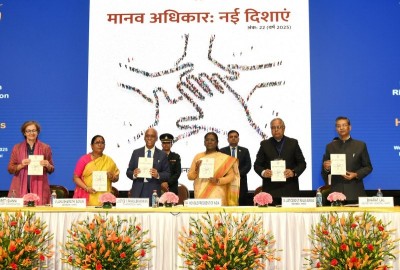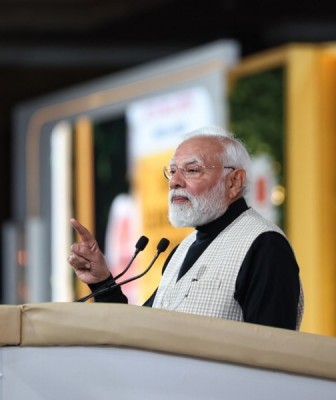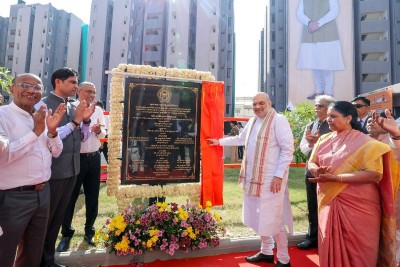VIIPs rising: India’s strategic pivot and the reshaping of global geopolitics
Renowned journalist Tsuchiya Hideo in his recent article, “Goodbye BRICS, Hello VIIPs—Southern Asia as the New Growth Hub” asserts that the VIIPs (Vietnam, India, Indonesia, and the Philippines) represent the next wave of economic powerhouses.
His analysis stems from the initial concept of the BRICS, formed in the early 21st century, which initially identified Brazil, Russia, India, and China as the primary drivers of global economic growth.
However, recent geopolitical expansions, driven by Beijing,seek to establish a bloc that rivals the G7. Anticipating China's potential stagnation, the focus of global growth is shifting towards India and the Association of Southeast Asian Nations (ASEAN). The VIIPs, with their promising economic potential, come to the forefront, indicating a dynamic shift in theglobal economic arena.
As South Korea and Taiwan grapple with population decline,this region emerges as a focal point for multinational corporations relocating their production bases from China.
The VIIPs, each with populations surpassing 100 million, embody the future of global economic prowess.India and Southeast Asia share a profound historical connection dating back to ancient times, characterized by rich religious, cultural, and trade ties.
This enduring relationship is rooted inthe diversity found in both regions, with a mosaic of ethnicities, religions,and languages, reflecting vibrant pluralistic societies.
Beyond the culturalconnection, India and Southeast Asia confront shared interests and challengesin crucial domains such as connectivity, development, security, and regional integration.
This interconnected past lays thefoundation for a present and future where collaborative efforts and mutual understanding continue to shape the dynamic interaction between India and the Southeast Asian region.
In recent years, India’s engagementwith Southeast Asia has intensified manifold getting a major fillip with the formulation of India’s Act East Policy which evolved out of the Look EastPolicy (LEP) formulated in the 1990s, by PM Narendra Modi in 2014.
LEP was basically an economic strategy whereas AEP added geostrategic dimensions to it. AEP also brought India’s Northeast region to the centre of India’s developmental as well as geopolitical strategy. AEP is geared towards developing markets and connectivity links with Southeast Asia, and this ActEast (through Northeast India) is now becoming Act Indo-Pacific policy.
A renewed focus on the 3Cs – Commerce,Culture and Connectivity along with maritime security, climate change, disastermanagement, traditional and non-traditional security aspects now encompass theIndia – Southeast Asia relationship.
With the objective of binding the two regions in closer connectivity to maximally realise the hitherto unexploited economic potential of both regions in the areas of trade, commerce, andinvestments, several modes of connectivity projects were initiated by India.
Some significant regional connectivity projects include the India-Myanmar-Thailand Trilateral (IMT) Highway and the Kaladan Multimodal Transit Transport Project.
The connectivity projects no longer remain limited to physical connectivity but an overlying emphasis is also beingput on digital connectivity. In this regard, digital connectivity projects have been scaled up with Cambodia, Lao PDR, Vietnam and Myanmar.India has a very robust mechanism inplace with ASEAN - Southeast Asia’s regional cooperative framework.
They have aFree Trade Agreement (FTA) in goods since 2010, and in services and investmentsince 2015.
The bilateral trade between India and ASEAN reached USD 86.9billion in FY 20, making ASEAN India’s fourth largest trading partner. The development cooperation between thetwo parties has also been gaining traction.
India has established three fundsto support cooperation projects with ASEAN member countries which include theASEAN-India Cooperation Fund, the ASEAN-India Green Fund, and the ASEAN-India Science and Technology Development Fund. Security and defence cooperation havealso become a major pillar of the India-ASEAN relationship.
India is a member of various ASEAN-ledmechanisms that deal with regional security aspects including the ASEAN Regional Forum (ARF), the ASEAN Defence Ministers’ Meeting Plus (ADMM+), andthe Expanded ASEAN Maritime Forum. India conducts regular joint military exercises with several ASEAN member countries, along with dialogues with ASEANconcerning issues like maritime security, cyber security, counter-terrorism,and humanitarian assistance, among others.
Additionally, India’s bilateral defence ties with several ASEAN members have been growing with BrahMos missiles being sold to Vietnam and the Philippines, developing a deep-sea port in Indonesia’s Aceh region, and developing Changi naval base in Singapore, amongstothers.
Prime Minister Modi participated in the20th ASEAN-India Summit and the 18th East Asia Summit (EAS) held in Jakarta onSeptember 7, 2023. During the ASEAN-India Summit, he engaged in comprehensive discussions aimed at fortifying the ASEAN-India Comprehensive Strategic Partnership.
Emphasizing ASEAN's centrality in the Indo-Pacific, he highlighted the alignment between India's Indo-Pacific Ocean's Initiative (IPOI) andASEAN’s Outlook on the Indo-Pacific (AOIP). A 12-point proposal was presented,encompassing key areas such as connectivity, digital transformation, trade, andstrategic engagement.
Joint Statements on Maritime Cooperation and Food Security were adopted, with Timor-Leste participating as an Observer. Atthe East Asia Summit, the Prime Minister reiterated India’s commitment tostrengthening the EAS mechanism, supporting ASEAN centrality, and advocatingfor a free, open, and rules-based Indo-Pacific.
He underscored collaborativeefforts on global challenges, including terrorism, climate change, andresilient supply chains, highlighting India's initiatives in climate action through ISA, CDRI, LiFE, and OSOWOG.
The recent spurts of visits by India’s External Affairs Minister Dr S. Jaishankar and Defence Minister Rajnath Singh to several Southeast Asian nations further lend weight to the burgeoning India-Southeast Asia ties. EAM’s two nation visit to Vietnam and Singapore inOctober this year marks a highlight in boosting bilateral ties with thesecountries.
During the talk with his Singaporean counterpart Ng Eng Hen, the focus was ondefence ties and maritime security. During his visit to Vietnam, DrJaishankar co-chaired the 18th meeting of the India-Vietnam Joint Commission oneconomic, trade and scientific and technological cooperation.
Security talks centred on Beijing and its belligerent and aggressive activitiesin the South China Sea and the Indian Ocean Region. Both sides reaffirmed theircommitment to ensuring peace, stability, safety, security and freedom ofnavigation and aviation, along with adherence to a rules-based order.
A comprehensive strategic partnership between India and Vietnam was identified asa key source of security, stability and progress in the region. Earlier in July 2023, S Jaishankar madea two-nation visit to Indonesia and Thailand wherein he attended meetings underthe India-ASEAN format, the BIMSTEC Foreign Ministers’ Retreat as well as theForeign Ministers' Meeting of the Mekong Ganga Cooperation Mechanism (MCG),making the visit highly productive.
Dr Jaishankar advanced India’s‘Neighbourhood First’ and ‘Act East’ policies, prioritising regionalintegration and strengthening ties with India’s Southeast Asian neighbours.
The inaugural Bay of Bengal Initiativefor Multi-Sectoral Technical and Economic Cooperation (BIMSTEC) ForeignMinisters' Retreat provided a platform for extensive discussions emphasising“strategies and approaches that would lead to strengthened growth and thepromotion of prosperity for all involved parties.”
Additionally, the 12thForeign Ministers' Meeting of the Mekong Ganga Cooperation Mechanism (MGC) wasalso attended in Bangkok by the Indian EAM. Engagement with member countries viz. Cambodia, Lao PDR, Myanmar, Thailand, and Vietnam provided India the opportunity to engage plurilater ally as well as bilaterally with these countries advancing the promotion of tourism, culture, education, as well astransport and communications.India's Defence Minister, RajnathSingh, bolstered the India-Southeast Asia relationship during his recent visitto Jakarta for the 10th ASEAN Defence Ministers’ Meeting-Plus (ADMM-Plus). The visit played a pivotal role in enhancing security and strategic cooperation between India and Southeast Asia.
Singh stressed the significance of adhering to established regulations. In the meeting, Indian Defence Minister reaffirmed India’s stand on ASEAN centrality in the Indo-Pacific region and called for an active collaboration among ASEAN-Plus countries and dialogue partners forpeace, prosperity & security in the region.
The minister highlighted India’sunwavering commitment to freedom of navigation, overflight and unimpeded lawful commerce on international waters. He urged the member countries for regional security initiatives that are consultative and development-oriented to reflect the larger consensus among various stakeholders.
India proposed to co-chair Expert Working Group onCounter-Terrorism endorsed by ADMM-Plus while recognising terrorism a serious threat to international peace and security.
His bilateral meetings with Indonesian and Vietnamese counterparts on the sidelines of the ADMM-Plusfocused on deepening of the multifaceted bilateral defence ties throughtraining, capacity building, defence industry cooperation, UN Peacekeeping,bilateral ship visits and joint military exercises.
The evolving territorial assertions ofthe People’s Republic of China in the Indo-Pacific have spurred a closerdefence rapport between New Delhi and Manila.
The Philippine Coast Guard'sremoval of a Chinese-installed barrier at Huangyan Dao in the South China Seaemphasized this shift. Both incidents, occurring within a month, underscore theunity among China's neighbouring nations in response to its security threat. India and the Philippines have expanded their security collaborations, aligningagainst China’s growing assertiveness, reflecting an increasing strategic alignment.
As the Indo-Philippines defence relationship strengthens, potentialmeasures range from economic coercion by China to enhanced security cooperationshort of a mutual defence treaty.
The growing proximity between New Delhi andManila signifies a pivotal development in the Indo-Pacific's evolvinggeopolitical dynamics.Dr. Rajkumar Ranjan Singh, Minister ofState for External Affairs and Education, is set to embark on an official visitto Malaysia from November 30 to December 2, 2023.
The visit aims to reinforcethe India-Malaysia Enhanced Strategic Partnership, established during PrimeMinister Shri Narendra Modi's visit in 2015, and build upon the outcomes of the India-Malaysia Joint Commission Meeting in New Delhi on November 7, 2023.
During the visit, MoS Singh will engage with various Malaysian ministers,attend the inaugural GOPIO International Business Summit & Expo on December 1, and participate in the GOPIO International Business Excellence Awards ceremony on December 2.
Additionally, he will inaugurate the Indian Workers ResourceCentre at the High Commission of India in Kuala Lumpur, interact with the Indian community, and partake in the 'Bhakti – the Musical' cultural program atthe Temple of Fine Arts. In conclusion, the geopolitical scenario is undergoing a seismic shift, with the VIIPs (Vietnam, India,Indonesia, and the Philippines) are emerging as economic powerhouses.
TsuchiyaHideo's assertion marks the end of the BRICS era, signalling a strategicrealignment. India's proactive engagement with Southeast Asia, epitomized bythe Act East Policy, emphasizes a digital and strategic dimension.
The ASEANpartnership, fortified by robust trade agreements and security collaborations,showcases India's commitment to regional stability. Recent high-profile visitsby Ministers Jaishankar and Singh underscore India's focus on defence ties,maritime security, and countering common threats. As India strengthens itsbonds with Southeast Asia, the evolving Indo-Pacific dynamics reflect a pivotalmoment in global geopolitics.
(About the writer: Dr. Maheep is an acclaimed scholar of India’s Foreign Policy. He has been teachingand conducting research in International Relations and Global Politics for overa decade.)
Support Our Journalism
We cannot do without you.. your contribution supports unbiased journalism
IBNS is not driven by any ism- not wokeism, not racism, not skewed secularism, not hyper right-wing or left liberal ideals, nor by any hardline religious beliefs or hyper nationalism. We want to serve you good old objective news, as they are. We do not judge or preach. We let people decide for themselves. We only try to present factual and well-sourced news.







